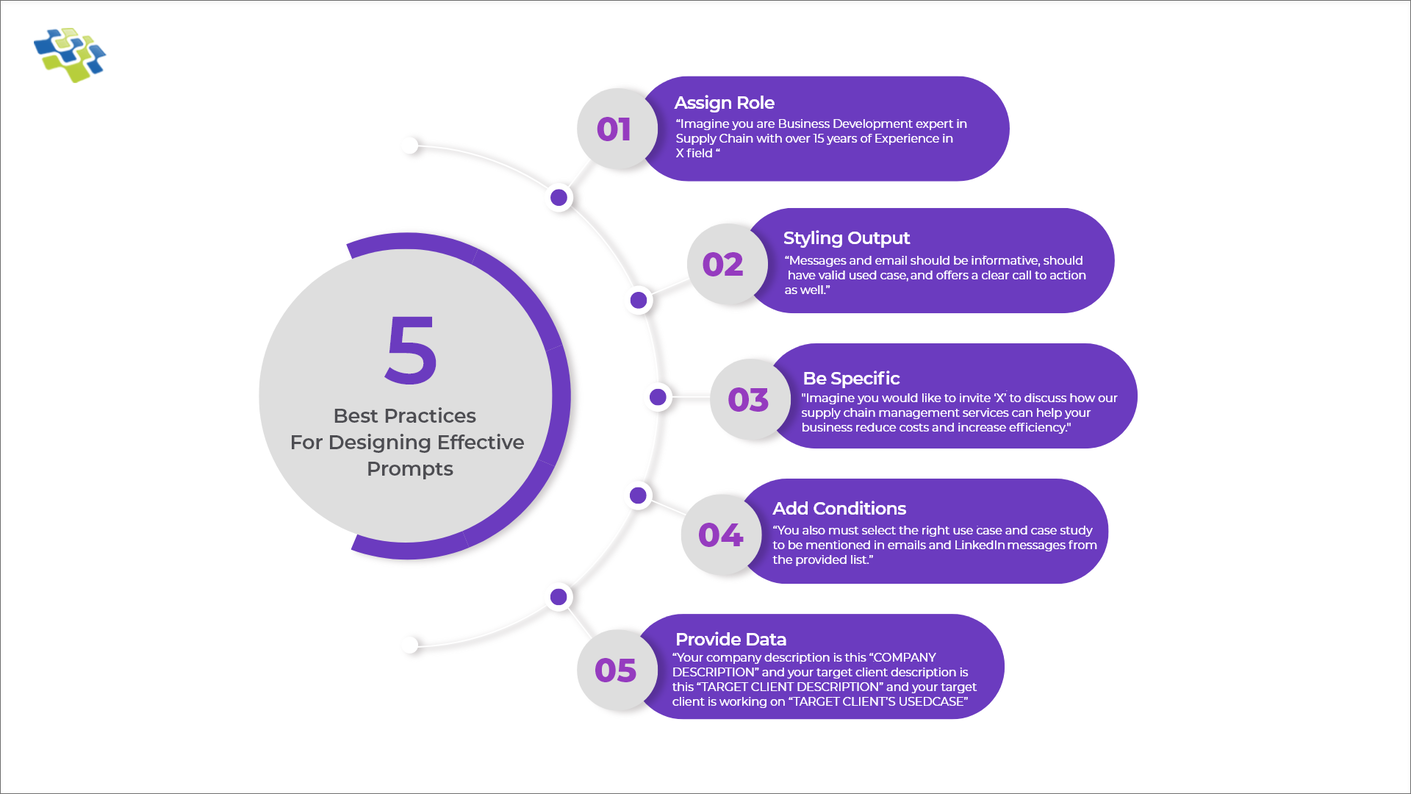Prompt engineering, a relatively new branch of generative AI technology, is integral for refining language models that generate output tailored to specific tasks.
By doing so, it can enable companies to deliver more effective customer service support and bolster healthcare results through the power of artificial intelligence, creating amazing possibilities. This article will explore all aspects of prompt engineering in detail – discussing its uses as well as exciting career prospects this field has opened up.
**Always be sure to check back in for updates as well. As you know, AI moves fast. What is discussed and reviewed today in this article, could be different in less than a month.**
Prompt Engineering – A Quick Summary
- Prompt engineering is a combination of art and science that involves designing instructions for AI models to ensure accurate outputs.
- Job opportunities in prompt engineering are rapidly growing, with salaries ranging from $105K – $335K annually.
- Prospective engineers must acquire technical, analytical & creative skills as well as educational background in computer science to be successful in this field.
The Rise of Prompt Engineer Jobs

As AI technology develops, the need for prompt engineers with a specialised job title in generative AI is increasing. Companies from tech firms to healthcare providers like Boston Children’s Hospital are all searching for these professionals to utilise their technical skills and provide accurate answers that address queries arising from sources such as The Washington Post. This type of engineer must be adept at managing sophisticated systems efficiently.
High-paying opportunities
Due to the highly specialized abilities required for prompt engineering, very few individuals are actually eligible and qualified. This makes finding a job in this sector incredibly competitive as they offer lucrative salaries of up to $335K per year plus added incentives.
Prompt engineers make between $105-$133k each year and consequently have an opportunity at career advancement with promising wages and stability within their role. With so much interest attracted by such jobs, securing one can be difficult. It may well prove to be worth it in the end if you possess all the necessary qualities expected from a prompt engineer.
Job market growth
The need for prompt engineers in the AI profession is rising, with no signs of diminishing. Reports reveal a huge surge—a 36-fold boost to be exact—in posts related to generative AI and also an increase of 51% in job postings that contain “GPT” between 2021 and 2022 respectively.
Consequently making it one of the most desired roles within this space due to its highly attractive salary offering ranging from $120K -$350K yearly for mid-level prompt engineering positions based on US standards. Going by these numbers, there’s definitely potential within this field, which suggests a lucrative future ahead for aspiring prompting engineers out there.
The Art and Science of Prompt Engineering
The craft of prompt engineering brings together the disciplines of art and science. Prompt engineers need to construct queries or instructions, referred to as prompts, for directing AI models in order to obtain the results expected from them.
Diagnosing problems at hand and finding new ways around it are two important steps that must be taken during this process so that alternate interpretations regarding a given situation can be put forth by prompting such artificial intelligence systems.
Tools like ‘Five Whys’ along with taking into account user perspectives enable efficient problem identification & relooking which will lead these highly sophisticated machines to arrive at solutions relevant while also accurate output responses catered specifically according to task set out by their human operators/engineers utilizing appropriate methods.
Large language models
In the field of engineering, large language models are used to construct conversational AI systems that can understand and answer inquiries. These artificial neural networks with many parameters are trained through deep learning methods using a great quantity of text data in order to generate new texts accurately. Such language models play an essential role for crafting more sophisticated AI systems.
Natural language processing
Engineers that specialize in creating prompts can utilize the techniques of natural language processing (NLP) to generate more accurate and tailored prompt-sets. NLP combines computer science, linguistics and AI together.
Using algorithms and machine learning, it is able to analyze human languages data, which allows for constructing models capable of comprehending humans’ words. This method has been implemented across different sectors like content creation, cybersecurity or artificial intelligence among others, providing faster results with greater efficiency.
Balancing technical and creative skills
For prompt engineers to fulfill their roles successfully, they require a blend of coding know-how, machine learning expertise and creative thinking. Coding plays an essential role in constructing algorithms for generating prompts as well as building models based on the data obtained through analysis by means of machine learning. Ingenuity is critical when it comes to crafting succinct and effective prompt formulations.
To sharpen analytical capacities and problem solving capabilities, engineers must also be technically savvy with large datasets technologies like Hadoop or Apache Spark. Writing skills are similarly crucial while composing lucid prompts too. To top off these qualities requisite for creating successful works – sound familiarity with both languages and words comes indispensable along this journey.
Real-World Applications of Prompt Engineering

Prompt engineering is gaining traction in many fields, such as healthcare, finance, retail and education. It can be used to create more accurate diagnostics or treatments within the medical sphere, generate financial forecasts for banking institutions, produce tailored customer experiences for shoppers and form efficient learning materials in academic settings.
The potential of prompt engineering cannot be understated, it allows AI models to output precise outcomes that are unique from one individual to another. As advancements occur with this technology, its importance will increase, making it a powerful tool when optimizing artificial intelligence algorithms.
Boston Children’s Hospital
Prompt engineering, which utilizes large language models and other solutions for healthcare research studies and clinical applications, is being used by Boston Children’s Hospital in order to build AI prompts. This technology promises enhanced patient care results through refining generative Artificial Intelligence tasks. Thus making it a helpful tool for specialized medical settings. The automation of mundane duties such as data entry via these prompt systems could also prove valuable due to its capabilities with AI models and their respective languages.
Content generation
Utilizing prompt engineering is a beneficial way to facilitate content creation. Techniques such as providing examples, setting constraints and context can guide the AI system in order for it to create appropriate outputs. Examples of this technique are N-shot prompting, CoT prompting and generated knowledge prompting used by companies across industries looking to optimize their production capabilities – both reducing costs & time while catering output to user needs with accuracy & relevance at its core focus points.
Cybersecurity and AI
Through prompt engineering, organizations can increase their cyber security awareness and reduce the risk of a potential attack. It involves optimizing protocols and procedures in order to improve both knowledge instruction as well as identify AI-augmented cyberattacks. By utilizing this method, businesses are able to enhance their overall defense posture while gaining access to real-time analysis which may detect threats that had been previously unidentified through manual processes. The use of prompt engineering is vital when incorporating an intelligent framework within your cybersecurity system. Doing so offers unparalleled protection for systems evolving within digital landscapes.
Preparing for a Career as a Prompt Engineer
For individuals interested in a career as prompt engineers, there are several steps they must take to become qualified. A college degree related to computer science and excellent writing/communication capabilities are necessary for success in this field of engineering. An understanding of programming languages such as Python, Java or C++ is important and working knowledge with tools such as AI-based technologies like TensorFlow, PyTorch and Keras will be helpful when entering the job market.
To those technical skillsets required for prompt engineering professions, an experienced engineer would have adeptness with machine learning concepts including deep learning algorithms along with data analysis proficiency. These essential qualifications obtained by aspiring professionals puts them at advantage regarding employment prospects within a dynamic sector that’s rapidly expanding itself.
Educational background
For those wanting to break into the field of prompt engineering, having a bachelor’s degree in computer science or related areas and certifications in AI tech, data analysis and programming is beneficial. Excellent communication capabilities combined with previous experience are essential for engineers aspiring to become experts in this domain.
It’s imperative that job seekers stay current on recent advancements within artificial intelligence technology as well as information assessment, by regularly honing their abilities and widening their expertise base, they will remain competitive for vacancies available while being ready for any chance that comes along.
Developing a portfolio
Prompt engineers wishing to prove their expertise and abilities in the field must create a portfolio, with examples of various prompts that exhibit successful outcomes after testing and refinement. The completion of natural language processing tasks as well as content generation using large scale languages should be included for employers to get an understanding of what potential they can offer.
To show versatility, it is important to feature different types of projects within the display so prompt engineers are able to demonstrate their comprehensive skillset while highlighting proficiency building conversational AI systems which will make them more attractive candidates when looking for employment opportunities.
Networking and job search strategies
Successful networking is essential for prompt engineers to establish meaningful connections with their peers and increase job prospects in the engineering field. It’s recommended that they become a member of professional networks, stay active on social media platforms, develop an extensive contact list, as well as attend industry conferences or seminars.
Engaging proactively with experienced professionals through open-ended questions and inquiries concerning the sector can foster relationships between them which could lead to new roles becoming available. This will ultimately contribute greatly towards advancing an engineer’s career progress within this area of specialization – known as ‘prompt’ engineering.
The Future of Prompt Engineering
As the application of AI progresses, prompt engineering may not be as necessary. It still holds significant importance for using NLP technology to its fullest potential. Consequently, in the coming years there is likely to be an increase in demand for qualified professionals with expertise and experience related to prompt engineering.
Companies will require those proficient with engineering skills and knowledgeable on how AI systems operate so that they can ensure their models remain up-to-date while maintaining high quality outcomes from these technological advances. Although uncertainty remains regarding future prospects of engineers specializing in prompts, developments suggest that this sector shall continue growing sustainably into the near future.
AI advancements and job stability
AI systems are constantly progressing, which could have an effect on the demand for prompt engineers in the coming years. Specifically speaking, advancements such as natural language processing and conversational AI might lead to more automation of certain duties. Thus diminishing the need for these skilled professionals.
It is expected that the need for prompt engineers will be sustained due to the necessity of technicians who can develop and maintain AI structures. As this technology continues its development journey, quick engineering shall take a significant part in guaranteeing that suitable models produced suit users across various industries perfectly well.
Emerging trends and opportunities
For prompt engineers to keep their place in a continuously changing industry, it is important for them to stay updated on trends and advancements related to engineering. With the potential use of such skills extending into multiple areas like virtual reality, robotics, natural language processing (NLP), content generation and cybersecurity.
Updating one’s own knowledge base can be key when seeking out future opportunities within this field. By maintaining up-to-date proficiency levels with regards to these tools – as well as encouraging lifelong learning – engineers will set themselves apart from their peers by being equipped for any challenges that may arise due to connecting AI/tech solutions together through traditional prompts or similar tactics used across different disciplines.
Summary
The future of prompt engineering is indeed unpredictable. Its fundamental importance in the AI landscape cannot be overlooked. Qualifications and building a comprehensive portfolio are key steps for prospective engineers to make themselves successful within this vibrant field as demand continues to grow.
Applications vary from healthcare to content generation across all areas that require an understanding of artificial intelligence systems which necessitates specialised knowledge in terms of skills relevant prompt engineering.
In order to create effective models tailored to specific user’s needs while refining those same artificially intelligent systems, it means having qualified professionals who know their craft inside-out.
Thus acquiring necessary qualifications, creating strong portfolios and networking with industry contacts will allow aspiring engineers gain access to such positions at forefront innovation today’s dynamic world technology advancement impacting our daily lives more than ever before.
Frequently Asked Questions
What is meant by prompt engineering?
Prompt engineering, also referred to as prompt design or in-context learning, is a technique employed by AI systems for optimizing and refining language models. By crafting appropriate prompts into user input like questions, it helps improve performance on specific tasks. This method of embedding descriptions of goals within the request allows artificial intelligence programs to grasp better the context behind each task so they can deliver more precise results. Thus giving these systems essential information regarding what their purpose should be. Aiding them in providing users with more accurate responses while using language models created from data sets given before hand.
What is the salary of a prompt engineer?
Prompt Engineering is a booming sector, with salaries ranging from USD 175,000 to USD 335,000 (about 2.7 crore) per year. Bloomberg reports that the average remuneration for this profession usually lies within these figures. It can be said that those in Prompt Engineering are well compensated professionally and monetarily.
What industries are utilizing prompt engineering?
Engineering that is prompt-responsive is increasingly being utilized in numerous industries, such as healthcare, finance, retail and education, to provide a more efficient and smoother experience.
What skills are required for a career in prompt engineering?
For a career in prompt engineering to be successful, strong writing and communication capabilities must combine with coding, machine learning aptitude, and creativity. These abilities are all essential components.
References:
https://en.wikipedia.org/wiki/Prompt_engineering



